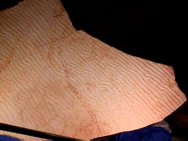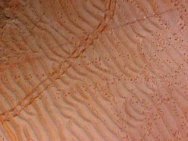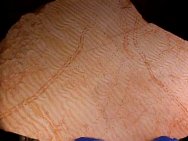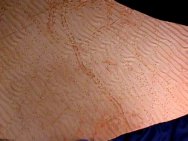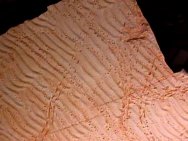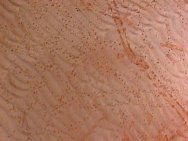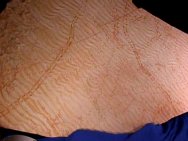Diplichnites sp. with Protichnites
Trace Fossils (Ichnofossils) - Arthropod Trackway
Geological Time: Upper Cambrian (about 510 million years ago)
Size: 38 x 52 inches
Fossil Site: Krukowski Quarry, Elk Mound Group, Mount Simon Sandstone, near Mosinee, Wisconsin
|
No
shelly animals are found in the Krukowski quarry, only trackways
(Ichnofossils) and body impressions (such as in the case of the
Jellyfish (Cnidarians). Besides a few mysterious trackways that
cannot be named, one finds Diplichnites,
Protichnites
and Climactichnites.
Together, this quarry tells a story just now being researched by
paleontologists - hopefully, the result will be some shedding of
more light on when and how life ventured from marine to Popular
conjecture is that generic Diplichnites is the trace of a arthropod,
such as wandering Myriapoda, which brings to mind an ancient centipede
(Chilopoda). Protichnites is a generic genus of trace fossil
that
are the imprints made by the feet of walking arthropods. These
fossils are normally found in what were shallow-water areas
and tidal zones
of Paleozoic shorelines, and are also known from the Cenozoic fossil
record. There is an enormous diversity of arthropods that could
have been responsible for Protichnites; In terms of the upper cambrian
Krukowski quarry, putative trackmakers include Euthycarcinoids,
Aglaspids,
and eurypterids. The Protichnites ichnogenus comprises two approximately
parallel rows footprints together with a longitudinal depression,
normally between footprint rows. The depression can
It is also possible that the same animal made both type of tracks, depending on behavior, locomotion, feeding behavior or even tide level - and so continues the mystery of these ichnofossils. This large specimen has a mryiad of footprints, footdrags or slashes, and tail drag marks left in the Cambrian-age sand. Interestingly, the specimen contains a gradient of track densities, with an extraordinarily high density (tracks upon tracks) of both Diplichnites and Protichnites tracks in the upper left. The upper left is suggestive of some kind of frenzied behavior, be it feeding, mating or other. To the down and right, the density of tracks diminishes, and the Protichnites tracks are absent. There has been no staining of this hyperrelief specimen. Also note the prototypical shoreline sand ripples that are common for many of the Krukowski quarry ichnofossils plates. Also see: Cambrian Shadows Theme Part |
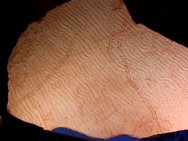
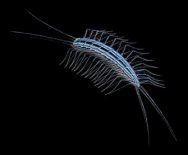 land environment.
land environment.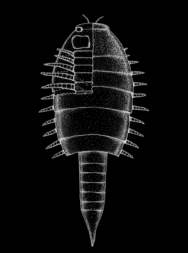 be
constant or piecewise dashes, and is considered to be the consequence
of a dragging body appendage such as a telson (tail). Diplichnites
is like Protichnites, but absent the tail drag tracks.
be
constant or piecewise dashes, and is considered to be the consequence
of a dragging body appendage such as a telson (tail). Diplichnites
is like Protichnites, but absent the tail drag tracks.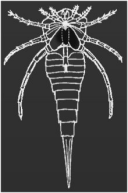 The
maker of the Protichnites fossil trackways might have been an animal
resembling the extant but ancient horseshoe crab, except of an early
design that lacked a hard shell to be preserved. Others have posited
that Protichnites was a soft-bodied progenitor of the large, now
extinct group of early predators, the Eurypterids (Chalicerate "biting
claws" Arthropods).
The
maker of the Protichnites fossil trackways might have been an animal
resembling the extant but ancient horseshoe crab, except of an early
design that lacked a hard shell to be preserved. Others have posited
that Protichnites was a soft-bodied progenitor of the large, now
extinct group of early predators, the Eurypterids (Chalicerate "biting
claws" Arthropods).